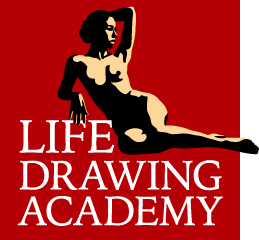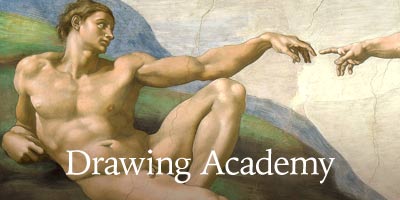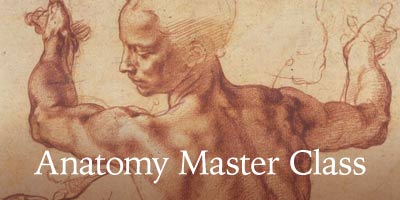Video by Vladimir London
Enroll in the Life Drawing Academy now!
21 Rules of Perspective
Tutorial by Vladimir London, the Life Drawing Academy tutor.
There are two main kinds of perspective - linear and aerial. Linear perspective deals with distortions, while aerial with the appearance of objects depending on depth. In this video, you will discover 21 rules of linear perspective.
Perspective Rule 1
There are 16 different types of linear perspective, however, in drawing and painting, you would mostly need one- and two-point perspectives. Here's the drawing from a one-point perspective. As you can see, all vanishing lines are converging into one vanishing point, which is located on the horizon. This kind of perspective can be used for depicting frontal views of geometric objects. This arched construction is a good example of such a perspective. However, if we look at such construction not frontally, but in the three-quarters view, we would need not one, but two-point perspective. In this case, vanishing lines would lead into two vanishing points, which also will be located on the horizon. So, the first rule is simple - in fine art, one- and two-point perspective will be sufficient in most cases.
Perspective Rule 2
Nevertheless, sometimes you may need a three-point perspective. This is when an object is seen obliquely from far above or below. Here's the drawing of the same arches in the three-quarters view seen from below. You can notice that its vertical lines are no longer depicted vertically, like in previous cases; they are tilted. Here's one more drawing in the three-point perspective. This time we look at the arches from above. This is like the bird-eye view. The second rule goes as follows - if we see an object obliquely from above or below, it might require a three-point perspective.
Perspective Rule 3
In some cases, to minimize distortions, instead of one-, two-, or three-point perspective, it is better to use the perceptive perspective. In this type of perspective, all vertical lines remain strictly vertical in drawing, but horizontal vanishing lines are not straight, but curved. They also converge into the vanishing point on the horizon, but this point is different than in the previous types. The perceptive perspective is suitable for interior drawings.
Perspective Rule 4
There is no such type of perspective that would be suited for every case. That is why there are so many different types and every single one of them would have some distortions. Such distortions will be different. They will include foreshortening, distorted angles, or bent lines.
Perspective Rule 5
Distortions are managed in different ways by various types of perspective. It is not about avoiding distortions, but minimizing them.
Perspective Rule 6
Those dimensions that are perpendicular to the line of sight would appear undistorted. This is usually the case for some lines in one-point perspective. All dimensions that are seen at some oblique angle would be foreshortened or distorted in some other way.
Perspective Rule 7
One artwork can combine several types of perspective. Every object, if placed at a different angle, would have different vanishing points. For example, in this drawing, we can see two books, a plate, a bottle and a vase. Every item is placed at a different angle and, therefore, it has different vanishing points. The plate is depicted in a one-point perspective. Its vanishing point is located on the horizon because this object is placed horizontally. The first book is seen in a two-point perspective. It lies horizontally and its two vanishing points are located on the same horizon. The top book is also horizontal, but we see it at a different angle. That is why its vanishing points would be on the same horizon, but differ from the first book. The bottle, however, is not horizontal; it is seen from below in the three-quarters view. In this case, we need to use a three-point perspective with three vanishing points. The first vanishing point is far above, beyond the drawing area. The second vanishing point is far below, also outside the drawing borders. While the third vanishing point is located on the horizon. This is because the bottom edge of this bottle is horizontal. When it comes to the reclining vase, despite its awkward position, we can actually use a simple one-point perspective. This is because a vase is a simple cylindrical object.
Perspective Rule 8
In linear perspective, those objects that are located closer to a viewer would appear bigger than the same size objects placed further away. For example, in this drawing, I will depict two geometric objects: a sphere, and a cone. I will use vanishing lines pointing to some dot on the horizon, to depict the same size sphere and cone placed far away. As you can see, the dimensions of the foreground objects in this drawing are greater than their twins in the background.
Perspective Rule 9
The objects in the foreground should be better defined than those in the background. To illustrate this rule, I will draw a landscape with a tree in the foreground and some trees and bushes in the background. As you can see in this drawing, the front tree is very detailed. I described its texture, depicted roots, branches and foliage; while the background trees are suggested rather than described.
Perspective Rule 10
If some objects are placed along the line of sight, the objects in the foreground would overlap other objects that are further away. In this drawing, the front prism is overlapping the second one; while the second prism is overlapping the third, and so on.
Perspective Rule 11
To illustrate this rule, I will draw a seascape with two boats and clouds. Two boats will be on the same sea level. One will be closer, and another further away. The boat in the foreground will appear in drawing further away from the horizon than the one in the background. The same goes for the clouds. Suppose they are on the same level in the sky. However, some clouds will be closer to us and therefore appear bigger than others further away and smaller according to rule number 8. I will now indicate the distances from the horizon to boats and clouds. As you can see, the boat in the background is depicted closer to the horizon line than the foreground boat. The same rule is applicable to clouds in this picture. The small clouds in the background will be located lower, which is closer to the horizon than the clouds in the foreground and therefore closer to a viewer. The same rule would apply to every object. For example, if two mountains are equal in height, but placed one closer and another further away, the background peak will be closer to the horizon than the top of the mountain in the foreground. We can see the same logic in the shoreline.
Perspective Rule 12
All parallel lines that are seen at some oblique angle and horizontal in life, will converge into the same vanishing point located on the horizon. We can use this rule in the reverse sequence. If some horizontal lines are converging into the same vanishing point, it would tell us that those lines are parallel in life. Using this rule, we can definitely say that in this masterpiece by Vermeer, the music instrument is parallel to the wall with a window. And we can also tell where the horizon level is. The chair, however, is not parallel to the walls. Its vanishing lines are converging into a different vanishing point. The back wall is perpendicular to the line of sight and therefore is undistorted. Its horizontal lines are strictly horizontal in drawing.
Perspective Rule 13
It is very easy to know where the horizon is; it is always at the eye level of a viewer. In artworks, this level is where the eyes of the artist are. I will make a fast sketch of a face and draw the horizon line at the level of eyes. Let's add a road with a pedestrian crossing and lamp posts and buildings. In life, it doesn't matter where you are, sitting or standing, the horizon will be at your eye level even if you do not see it. Here's the masterpiece by Vermeer. The horizon line is easy to find in this picture. We know that the artist painted it from some elevation because the standing figures are below the horizon. Should the master be at the same level as those figures, the picture would look very different.
Perspective Rule 14
In the Life Drawing Academy course, as an art tutor, I often receive questions on how to depict objects in perspective if you do not see the vanishing points or if such points are beyond the drawing area. You need to measure visible angles of vanishing lines from life, instead of looking for virtual vanishing points. For example, in this painting by Vermeer, the table and the bench are in one-point perspective. Its vanishing point is easy to plot. It is on the horizon, which is at the eye level of a sitting figure. This tells us that the artist was sitting when painting this masterpiece. However, the chair is depicted in a two-point perspective, and its vanishing points are beyond the picture area.
Perspective Rule 15
To realistically draw greatly foreshortened objects, it is better to use contours than outlines. For example, here is a sketch of a hand. We can tell it is a hand because every finger is depicted with contours. We can see their foreshortened cylindrical shapes even though these fingers are pointing at us. If we outline this drawing, I will do it in red line, you would notice that such an outline tells very little of the hand's three-dimensional nature. Here it is, placed separately. There are indefinite contours that can be drawn for a single object, but in most cases, only one outline.
Perspective Rule 16
In one- and two-point perspective, all vertical lines must be depicted absolutely vertically.
Perspective Rule 17
Circles in perspective appear as perfect elliptical ovals. Main axes of horizontal circles are strictly horizontal in perspective drawing. I will draw those axes in orange lines here. Here's the vase depicted with the help of elliptical contours. Every oval in this drawing is horizontal, so are their axes. The plate is placed next to this vase. It also consists of circular shapes that appear as ovals in this perspective drawing.
Perspective Rule 18
The circles at different levels will appear with different roundness. The closer a circle to the eye level or horizon, the slimmer it is. I will draw several circles in perspective to illustrate this rule. They all have the same size and the same proximity to a viewer. However, their shapes in this drawing change from bottom to top oval. The bottom oval is the fullest. While the circle at the eye level looks like a straight line, not an oval, because it coincides with the horizon. The same rule works for the circles, which we see from below. They are depicted above the horizon. The further an oval from the horizon is, the fuller it looks.
Perspective Rule 19
The partly visible elliptical end of a cylinder will always appear fuller than the fully visible oval at another end.
Perspective Rule 20
The invisible side of a prism will always appear less foreshortened than the opposite, fully visible side.
Perspective Rule 21
All the rules mentioned above can be purposely adjusted according to the creative task of an artist. For example, in life, there is only one horizon level for a given elevation of a viewer. However, an artist can use multiple horizons or vanishing levels in one picture to create a better-looking composition. This, of course, should be done with the knowledge, on purpose, rather than by mistake or misunderstanding of perspective rules.
To learn good drawing techniques, enroll in the Life Drawing Academy course:
Online Course
A self-study, self-paced course for you to learn fundamental methods of classical drawing and improve life drawing skills by watching video lessons and doing assignments
- Unlimited access to 52 life drawing video lessons
- Lifetime membership without deadlines
- Unlimited support from the Academy tutors
- Constructive critique of your artworks
- Member access to the Academy's Art community
- Place in the Academy's Students Gallery
- Exclusive members-only newsletter and bonuses
- Life Drawing Academy Diploma of Excellence in your name
One-time payment - Lifetime membership
$297 USD
Personal Tutoring Online + Online Course
The ultimate choice if you who would like to receive personal, one-to-one tutoring from the Academy teachers, which is custom-tailored to your skills and needs
- Everything in Online Course, plus:
- Dedicated team of art tutors
- Assessment of your current level of drawing skills
- Personalized curriculum tailored to your skills and goals
- Up to 100 drawing tasks with by-task assessment
- Unlimited one-to-one personal coaching with detailed per-task instructions and feedback
- Artwork critiques and results-oriented guidance
One-time payment - Lifetime membership
$997 USD




